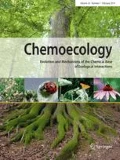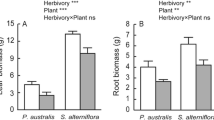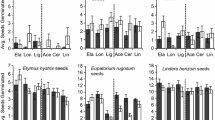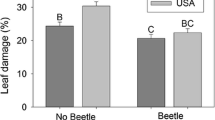Abstract
Chemical defenses are thought to contribute to the invasion success and impacts of many introduced plants; however, for most of these species, little is known about these compounds and how they vary in natural environments. Plant allelochemical concentrations may be affected by a variety of abiotic and biotic factors, including soil nutrients and herbivores. Moreover, such quantitative variation is likely to play an important role in species interactions involving these invasive plants. The purpose of this study was to examine patterns of variation in iridoid glycoside concentrations of the invasive plant Linaria dalmatica (Plantaginaceae). We conducted a greenhouse experiment to investigate the effect of soil nitrogen availability on iridoid glycoside concentrations. Results from this experiment showed that plant iridoid glycoside concentrations decreased with increased nitrogen availability. Additionally, plants were collected from multiple field sites in order to characterize the influence of population, soil nitrogen availability, and herbivore attack on iridoid glycoside variation. Results from field studies indicated that plants demonstrated considerable seasonal variation, as well as variation within and among populations, with iridoid glycoside concentrations ranging from approximately 1 to 15% dry weight. The relationship between soil nitrogen and plant iridoid glycosides varied among populations, with a strong negative correlation in one population, a marginally significant negative relationship in a second population, and no relationship in the remaining two populations. Additionally, we found a negative relationship between iridoid glycoside concentrations and plant injury by an introduced biocontrol agent, the stem-mining weevil Mecinus janthinus (Cucurlionidae). These results show that plant allelochemical concentrations can vary widely in natural environments and suggest that levels of plant defense may be reduced by increased soil nitrogen availability and herbivore attack in this invasive plant species.





Similar content being viewed by others
References
Adler LS, Schmitt J, Bowers MD (1995) Genetic variation in defensive chemistry in Plantago lanceolata (Plantaginaceae) and its effect on the specialist herbivore Junonia coenia (Nymphalidae). Oecologia 101:75–85
Alex JF (1962) The taxonomy, history, and distribution of Linaria dalmatica. Can J Bot 40:295–307
Barton KE (2007) Early ontogenetic patterns in chemical defense in Plantago (Plantaginaceae): Genetic variation and trade-offs. Am J Bot 94:56–66
Barton KE (2008) Phenotypic plasticity in seedling defense strategies: compensatory growth and chemical induction. Oikos 117:917–925
Barton KE, Bowers MD (2006) Neighbor species differentially alter resistance phenotypes in Plantago. Oecologia 150:442–452
Bazzaz FA, Chiariello NR, Coley PD, Pitelka LF (1987) Allocating resources to reproduction and defense. Bioscience 37:58–67
Beninger CW, Cloutier RR, Grodzinski B (2008) The iridoid glucoside, antirrhinoside, from Antirrhinum majus L. has differential effects on two generalist insect herbivores. J Chem Ecol 34:591–600
Bidart-Bouzat MG, Imeh-Nathaniel A (2008) Global change effects on plant chemical defenses against insect herbivores. J Integr Plant Bio 50:1339–1354
Biere A, Marak HB, van Damme JMM (2004) Plant chemical defense against herbivores and pathogens: generalized defense or trade-offs? Oecologia 140:430–441
Binkley D, Vitousek PM (1987) Soil nutrient availability. In: Pearcy RW, Ehleringer JR, Mooney HA, Rundel RW (eds) Physiological plant ecology: field methods and instrumentation. Chapman and Hall, London, pp 75–96
Blossey B, Notzold R (1995) Evolution of increased competitive ability in invasive nonindigenous plants—a hypothesis. J Ecol 83:887–889
Blumenthal DN (2005) Interrelated causes of plant invasion. Science 310:243–244
Blumenthal DM (2006) Interactions between resource availability and enemy release in plant invasion. Ecol Lett 9:887–895
Boros CA, Stermitz FR (1990) Iridoids. An Updated Review, Part I. J Nat Prod 53:1055–1147
Boros CA, Stermitz FR (1991) Iridoids. An Updated Review, Part 2. J Nat Prod 54:1173–1246
Bossdorf O, Auge H, Lafuma L, Rogers WE, Siemann E, Prati D (2005) Phenotypic and genetic differentiation between native and introduced plant populations. Oecologia 144:1–11
Bowers MD (1984) Iridoid glycosides and host-plant specificity in larvae of the buckeye butterfly, Junonia coenia (Nymphalidae). J Chem Ecol 10:1567–1577
Bowers MD (1991) Iridoid glycosides. In: Rosenthal GA, Berenbaum MR (eds) Herbivores: their interactions with secondary plant metabolites. Academic Press, New York, pp 297–326
Bowers MD, Puttick GM (1989) Iridoid glycosides and insect feeding preferences—gypsy moths (Lymantria dispar, Lymantriidae) and buckeyes (Junonia coenia, Nymphalidae). Ecol Entomol 14:247–256
Bowers MD, Stamp NE (1993) Effects of plant age, genotype, and herbivory on Plantago performance and chemistry. Ecology 74:1778–1791
Bowers MD, Collinge SK, Gamble SE, Schmitt J (1992) Effects of genotype, habitat, and seasonal variation on iridoid glycoside content of Plantago lanceolata (Plantaginaceae) and the implications for insect herbivores. Oecologia 91:201–207
Bowman WD, Bahn L, Damm M (2003) Alpine landscape variation in foliar nitrogen and phosphorus concentrations and the relation to soil nitrogen and phosphorus availability. Arctic, Antarctic, and Alpine Research 35:144–149
Bryant JP, Chapin FS, Klein DR (1983) Carbon Nutrient Balance of Boreal Plants in Relation to Vertebrate Herbivory. Oikos 40:357–368
Burke IC, Lauenroth WK, Parton WJ (1997) Regional and temporal variation in net primary production and nitrogen mineralization in grasslands. Ecology 78:1330–1340
Callaway RM, Aschehoug ET (2000) Invasive plants versus their new and old neighbors: a mechanism for exotic invasion. Science 290:521–523
Callaway RM, Ridenour WM (2004) Novel weapons: invasive success and the evolution of increased competitive ability. Front Ecol Environ 2:436–443
Cappuccino N, Arnason JT (2006) Novel chemistry of invasive exotic plants. Biol Lett 2:189–193
Chapin FS III, Bloom AJ, Field CB, Waring RH (1987) Plant responses to multiple environmental factors. Bioscience 37:49–57
Coley PD, Bryant JP, Chapin FS (1985) Resource Availability and Plant Antiherbivore Defense. Science 230:895–899
Darrow K, Bowers MD (1999) Effects of herbivore damage and nutrient level on induction of iridoid glycosides in Plantago lanceolata. J Chem Ecol 25:1427–1440
Davis MA, Grime JP, Thompson K (2000) Fluctuating resources in plant communities: a general theory of invasibility. J Ecol 88:528–534
El-Naggar LJ, Beal JL (1980) Iridoids. A Review. J Nat Prod 43:649–707
Fajer ED, Bowers MD, Bazzaz FA (1992) The effect of nutrients and enriched CO2 environments on production of carbon-based allelochemicals in Plantago—a test of the carbon nutrient balance hypothesis. Am Nat 140:707–723
Franzyk H, Jensen SR, Thale Z, Olsen CE (1999) Halohydrins and polyols derived from antirrhinoside: Structural revisions of muralioside and epimuralioside. J Nat Prod 62:275–278
Fuchs A, Bowers MD (2004) Patterns of iridoid glycoside production and induction in Plantago lanceolata and the importance of plant age. J Chem Ecol 30:1723–1741
Gardner DR, Stermitz FR (1988) Host plant utilization and iridoid glycoside sequestration by Euphydryas anicia (Lepidoptera, Nymphalidae). J Chem Ecol 14:2147–2168
Gowan E, Lewis BA, Turgeon R (1995) Phloem transport of antirrhinoside, an iridoid glycoside, in Asarina scandens (Scrophulariaceae). J Chem Ecol 21:1781–1788
Hamilton JG, Zangerl AR, Delucia EH, Berenbaum MR (2001) The carbon-nutrient balance hypothesis: its rise and fall. Ecol Lett 4:86–95
Handjieva NV, Ilieva EI, Spassov SL, Popov SS (1993) Iridoid glycosides from Linaria species. Tetrahedron 49:9261–9266
Harvey JA, Van Nouhuys S, Biere A (2005) Effects of quantitative variation in allelochemicals in Plantago lanceolata on development of a generalist and a specialist herbivore and their endoparasitoids. J Chem Ecol 31:287–302
Herms DA, Mattson WJ (1992) The dilemma of plants: to grow or defend. Q Rev Biol 67:283–335
Hierro JL, Callaway RM (2003) Allelopathy and exotic plant invasion. Plant Soil 256:29–39
Inderjit, Callaway RM, Vivanco JM (2006) Can plant biochemistry contribute to understanding of invasion ecology? Trends Plant Sci 11:574–580
Jamieson MA, Bowers MD (2010) Iridoid glycoside variation in the invasive plant Dalmatian toadflax, Linaria dalmatica (Plantaginaceae), and sequestration by the biological control agent, Calophasia lunula. J Chem Ecol 36:70–79
Jeanneret P, Schroeder C (1992) Biology and host specificity of Mecinus janthinus Germar (Col: Curculionidae), a candidate for the biological control of yellow and Dalmatian toadflax, Linaria vulgaris (L.) Mill. and Linaria dalmatica (L.) Mill. (Scrophulariaceae) in North American. Biocontrol Sci Technol 2:25–34
Karban R (2011) The ecology and evolution of induced resistance against herbivores. Funct Ecol 25:339–347
Karban R, Baldwin IT (1997) Induced responses to herbivory. University of Chicago Press, Chicago
Karban R, Myers JH (1989) Induced Plant-Responses to Herbivory. Annu Rev Ecol Syst 20:331–348
Keane RM, Crawley MJ (2002) Exotic plant invasions and the enemy release hypothesis. Trends Ecol Evol 117:164–169
Klockars GK, Bowers MD, Cooney B (1993) Leaf variation in iridoid glycoside content of Plantago lanceolata (Plantaginaceae) and oviposition of the Buckeye, Junonia coenia (Nymphalidae). Chemoecology 4:72–78
Koricheva J, Larsson S, Haukioja E, Keinanen M (1998) Regulation of woody plant secondary metabolism by resource availability: hypothesis testing by means of meta-analysis. Oikos 83:212–226
Logan BA, Demming-Adams B, Rosenstiel TN, Adams WW (1999) Effect of nitrogen limitation on foliar antioxidants in relationship to other metabolic characteristics. Planta 209:213–220
Marak HB, Biere A, van Damme JMM (2002) Two herbivore-deterrent iridoid glycosides reduce the in vitro growth of a specialist but not of a generalist pathogenic fungus of Plantago lanceolata L. Chemoecology 12:185–192
Mitchell CE, Agrawal AA, Bever JD, Gilbert GS, Hufbauer RA, Klironomos JN, Maron JL, Morris WF, Parker IM, Power AG, Seabloom EW, Torchin ME, Vazquez DP (2006) Biotic interactions and plant invasions. Ecol Lett 9:726–740
Nieminen M, Suomi J, Van Nouhuys S, Sauri P, Riekkola ML (2003) Effect of iridoid glycoside content on oviposition host plant choice and parasitism in a specialist herbivore. J Chem Ecol 29:823–844
Nykänen H, Koricheva J (2004) Damage-induced changes in woody plants and their effects on insect herbivore performance: a meta-analysis. Oikos 104:247–268
Orians CM, Ward D (2010) Evolution of plant defenses in nonindigenous environments. Annu Rev Entomol 55:439–459
Pereyra PC, Bowers MD (1988) Iridoid glycosides as oviposition stimulants for the Buckeye butterfly, Junonia coenia (Nymphalidae). J Chem Ecol 14:917–928
Peterson RKD, Sing SE, Weaver DK (2005) Differential physiological responses of Dalmatian toadflax, Linaria dalmatica L. Miller, to injury from two insect biological control agents: Implications for decision-making in biological control. Environ Entomol 34:899–905
Prudic KL, Oliver JC, Bowers MD (2005) Soil nutrient effects on oviposition preference, larval performance, and chemical defense of a specialist insect herbivore. Oecologia 143:578–587
Reudler Talsma JH, Biere A, Harvey JA, van Nouhuys S (2008) Oviposition cues for a specialist butterfly-plant chemistry and size. J Chem Ecol 34:1202–1212
Saastamoinen M, van Nouhuys S, Nieminen M, O’Hara B, Suomi J (2007) Development and survival of a specialist herbivore, Melitaea cinxia, on host plants producing high and low concentrations of iridoid glycosides. Ann Zool Fenn 44:70–80
Saner MA, Jeanneret P, Mullerscharer H (1994) Interaction among two biological control agents and the developmental stage of their target weed, Dalmatian Toadflax, Linaria dalmatica (L) Mill (Scrophulariaceae). Biocontrol Sci Techn 4:215–222
Stamp N (2003) Out of the quagmire of plant defense hypotheses. Q Rev Biol 78:23–55
Stamp N (2004) Can the growth-differentiation balance hypothesis be tested rigorously? Oikos 107:439–448
USDA, NRCS (2009a) The PLANTS Database. National Plant Data Center, Baton Rouge, LA 70874-4490 USA. Available online at http://plants.usda.gov (accessed June 2, 2009)
USDA, NRCS (2009b) Soil Survey Staff, Natural Resources Conservation Service, United States Department of Agriculture. Web Soil Survey. Available online at http://websoilsurvey.nrcs.usda.gov (accessed June 2, 2009)
Van Hezewijk BH, Bourchier RS, De Clerck-Floate RA (2010) Regional-scale impact of the weed biocontrol agent Mecinus janthinus on Dalmatian toadflax (Linaria dalmatica). Biol Control 55:197–202
Vujnovic K, Wein RW (1996) The biology of Canadian weeds. 106. Linaria dalmatica (L.) Mill. Can J Plant Sci 77:483–491
Ward SM, Fleischmann CE, Turner MF, Sing SE (2009) Hybridization between invasive populations of Dalmatian toadflax (Linaria genistifolia subsp. dalmatica) and yellow toadflax (Linaria vulgaris). Invasive Plant Science and Management. Invasive Plant Sci Management 2:369–378
Weber WA, Wittmann RC (2001) Colorado flora: Eastern slope, 3rd edn. University Press of Colorado, Boulder, CO
Wilson LM, Sing SE, Piper GL, Hansen RW, De Clerck-Floate R, MacKinnon DK, Randall C (2005) Biology and biological control of Dalmatian and yellow toadflax. USDA Forest Service, FHTET-05-13
Wurst S, Van Dam NM, Monroy F, Biere A, Van der Putten WH (2008) Intraspecific variation in plant defense alters effects of root herbivores on leaf chemistry and aboveground herbivore damage. J Chem Ecol 34:1360–1367
Zangerl AR, Berenbaum MR (2005) Increase in toxicity of an invasive weed after reassociation with its coevolved herbivore. P Natl Acad Sci-Biol 102:15529–15532
Zangerl AR, Berenbaum MR (2008) Selection for chemical trait remixing in an invasive weed after reassociation with a coevolved specialist. P Natl Acad Sci-Biol 105:4547–4552
Acknowledgments
Many thanks to Sarah Travers, Patrick Travers, and Nicole Won for field and laboratory assistance. We also thank the City of Boulder, Boulder County, and Linda and Sergio Sanabria for use of their land to conduct research. Timothy Seastedt, William Bowman, Susan Beatty, and Yan Linhart provided helpful comments and feedback on drafts of this manuscript. And finally, we are appreciative of the thoughtful comments provided by two anonymous reviewers. Funding for this project was provided by Boulder County Open Space and Parks, the Department of Ecology and Evolutionary Biology at the University of Colorado, the Hazel Schmoll Research Fellowship in Colorado Botany, and National Science Foundation grants DEB 0614883 and 0808473.
Author information
Authors and Affiliations
Corresponding author
Rights and permissions
About this article
Cite this article
Jamieson, M.A., Bowers, M.D. Soil nitrogen availability and herbivore attack influence the chemical defenses of an invasive plant (Linaria dalmatica; Plantaginaceae). Chemoecology 22, 1–11 (2012). https://doi.org/10.1007/s00049-011-0087-1
Received:
Accepted:
Published:
Issue Date:
DOI: https://doi.org/10.1007/s00049-011-0087-1




